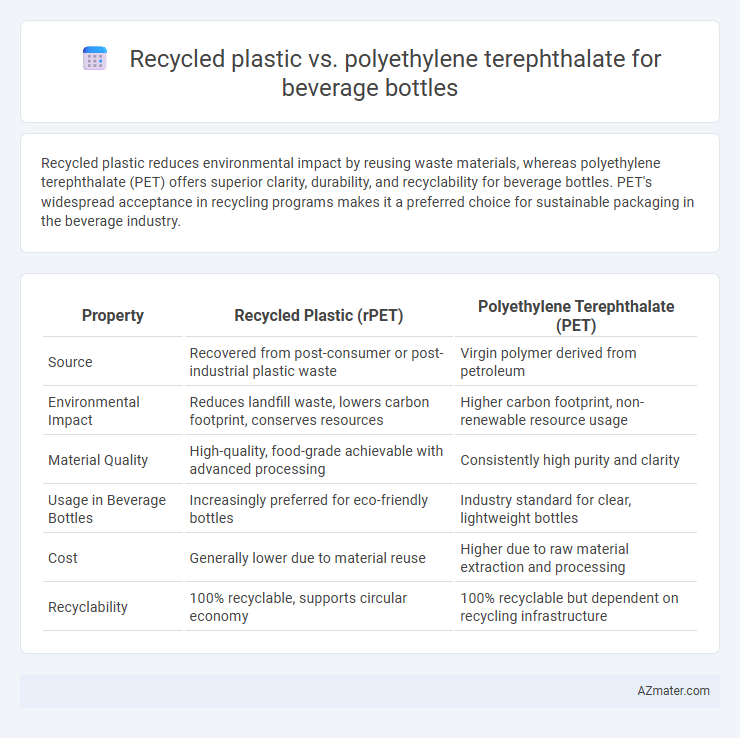Recycled plastic reduces environmental impact by reusing waste materials, whereas polyethylene terephthalate (PET) offers superior clarity, durability, and recyclability for beverage bottles. PET's widespread acceptance in recycling programs makes it a preferred choice for sustainable packaging in the beverage industry.
Table of Comparison
| Property | Recycled Plastic (rPET) | Polyethylene Terephthalate (PET) |
|---|---|---|
| Source | Recovered from post-consumer or post-industrial plastic waste | Virgin polymer derived from petroleum |
| Environmental Impact | Reduces landfill waste, lowers carbon footprint, conserves resources | Higher carbon footprint, non-renewable resource usage |
| Material Quality | High-quality, food-grade achievable with advanced processing | Consistently high purity and clarity |
| Usage in Beverage Bottles | Increasingly preferred for eco-friendly bottles | Industry standard for clear, lightweight bottles |
| Cost | Generally lower due to material reuse | Higher due to raw material extraction and processing |
| Recyclability | 100% recyclable, supports circular economy | 100% recyclable but dependent on recycling infrastructure |
Introduction to Beverage Bottle Materials
Beverage bottles primarily use materials like recycled plastic and polyethylene terephthalate (PET) due to their durability, lightweight nature, and chemical resistance. PET is favored for its clarity, strength, and excellent barrier properties, which preserve beverage freshness. Recycled plastics, including recycled PET (rPET), offer sustainable alternatives by reducing environmental impact while maintaining comparable performance standards.
Overview of Recycled Plastic in Packaging
Recycled plastic in beverage bottle packaging primarily involves the use of post-consumer polyethylene terephthalate (rPET), which significantly reduces environmental impact by lowering energy consumption and greenhouse gas emissions compared to virgin PET production. This eco-friendly material retains essential barrier properties and clarity, making it a sustainable alternative without compromising bottle performance. The adoption of rPET supports circular economy goals by diverting plastic waste from landfills and reducing reliance on fossil fuels for new resin manufacturing.
Understanding Polyethylene Terephthalate (PET)
Polyethylene terephthalate (PET) is a widely used thermoplastic polymer in beverage bottles due to its excellent strength, lightweight nature, and high clarity. PET offers superior barrier properties against carbon dioxide and oxygen, preserving beverage freshness and extending shelf life. Unlike many recycled plastics, PET can be efficiently recycled into new bottles, reducing environmental impact while maintaining quality standards.
Production Processes: Recycled Plastic vs PET
Recycled plastic for beverage bottles involves collecting, sorting, cleaning, and reprocessing post-consumer or post-industrial plastics into usable raw materials, significantly reducing the demand for virgin resources and energy consumption. Polyethylene terephthalate (PET) production starts from petrochemical raw materials such as ethylene glycol and terephthalic acid, undergoing polymerization and molding processes to create a lightweight, durable, and food-safe packaging material. While PET production requires fossil-fuel extraction and extensive energy input, recycled plastic leverages existing polymers, minimizing carbon footprint but often necessitating additional sorting and contaminant removal to ensure material quality and safety compliance.
Environmental Impact: Life Cycle Analysis
Recycled plastic bottles generally show a lower environmental impact compared to virgin polyethylene terephthalate (PET) in life cycle analysis, with significant reductions in energy consumption and greenhouse gas emissions during production. The use of recycled PET reduces reliance on fossil fuels and decreases waste sent to landfills, contributing to a circular economy for beverage packaging. However, challenges remain in maintaining material quality and recycling efficiency to maximize these environmental benefits.
Material Properties and Performance Comparison
Recycled plastic used in beverage bottles often includes materials like recycled polyethylene terephthalate (rPET), which maintains similar strength, clarity, and barrier properties as virgin polyethylene terephthalate (PET), making it suitable for reuse in packaging applications. PET exhibits excellent impact resistance, chemical stability, and moisture barrier performance, ensuring beverage freshness and safety, while recycled PET may show slight variations in color and mechanical properties due to polymer degradation during processing. The choice between recycled plastic and virgin PET depends on balancing sustainability goals with maintaining the structural integrity and transparency essential for consumer appeal and product protection.
Safety and Regulatory Compliance
Recycled plastic used for beverage bottles must meet stringent safety standards to ensure the absence of contaminants and harmful substances, complying with regulations such as FDA Title 21 CFR and EU Regulation No. 10/2011. Polyethylene terephthalate (PET) inherently provides a strong barrier against moisture and gases, ensuring product integrity while being widely approved for direct food contact by global safety authorities. Compliance with migration limits, heavy metal restrictions, and microbial safety assessments are critical factors distinguishing recycled plastics from virgin PET in beverage applications.
Economic Considerations and Market Trends
Recycled plastic for beverage bottles reduces raw material costs by reusing post-consumer waste, which supports circular economy initiatives and satisfies growing consumer demand for sustainable packaging. Polyethylene terephthalate (PET) remains dominant due to its light weight, durability, and recyclability, driving a competitive market that values material efficiency and cost-effectiveness. Market trends indicate increasing investment in advanced recycling technologies and regulatory policies favoring recycled content mandates, influencing pricing dynamics and supply chain strategies.
Consumer Perceptions and Acceptance
Consumer perceptions of recycled plastic versus polyethylene terephthalate (PET) in beverage bottles hinge primarily on environmental impact and safety concerns. PET is widely accepted for its clarity, durability, and safety, while recycled plastic sometimes faces skepticism due to perceived contamination risks and potential compromise in quality. Studies reveal growing consumer willingness to choose recycled plastic bottles when transparency about recycling processes and quality standards is provided.
Future Innovations in Beverage Bottle Materials
Future innovations in beverage bottle materials emphasize enhancing recycled plastic quality and developing advanced polyethylene terephthalate (PET) formulations to improve sustainability and performance. Breakthroughs in bio-based PET and chemical recycling techniques aim to reduce environmental impact while maintaining bottle clarity and strength. Emerging antimicrobial additives and lightweight designs promise to extend shelf life and optimize resource efficiency in beverage packaging.

Infographic: Recycled plastic vs Polyethylene terephthalate for Beverage bottle
 azmater.com
azmater.com